Pav Bhaji is the ultimate street food from Mumbai, India. It's a delicious mash of potatoes, tomatoes, onions, cauliflower, green peppers, green peas and spices, and you scoop it up with an airy, soft pav -- a bread roll. It's also a remarkably easy dish to make, and it comes together in minutes. You can make it gluten-free by using gf bread rolls. A vegan, soy-free and nut-free recipe.
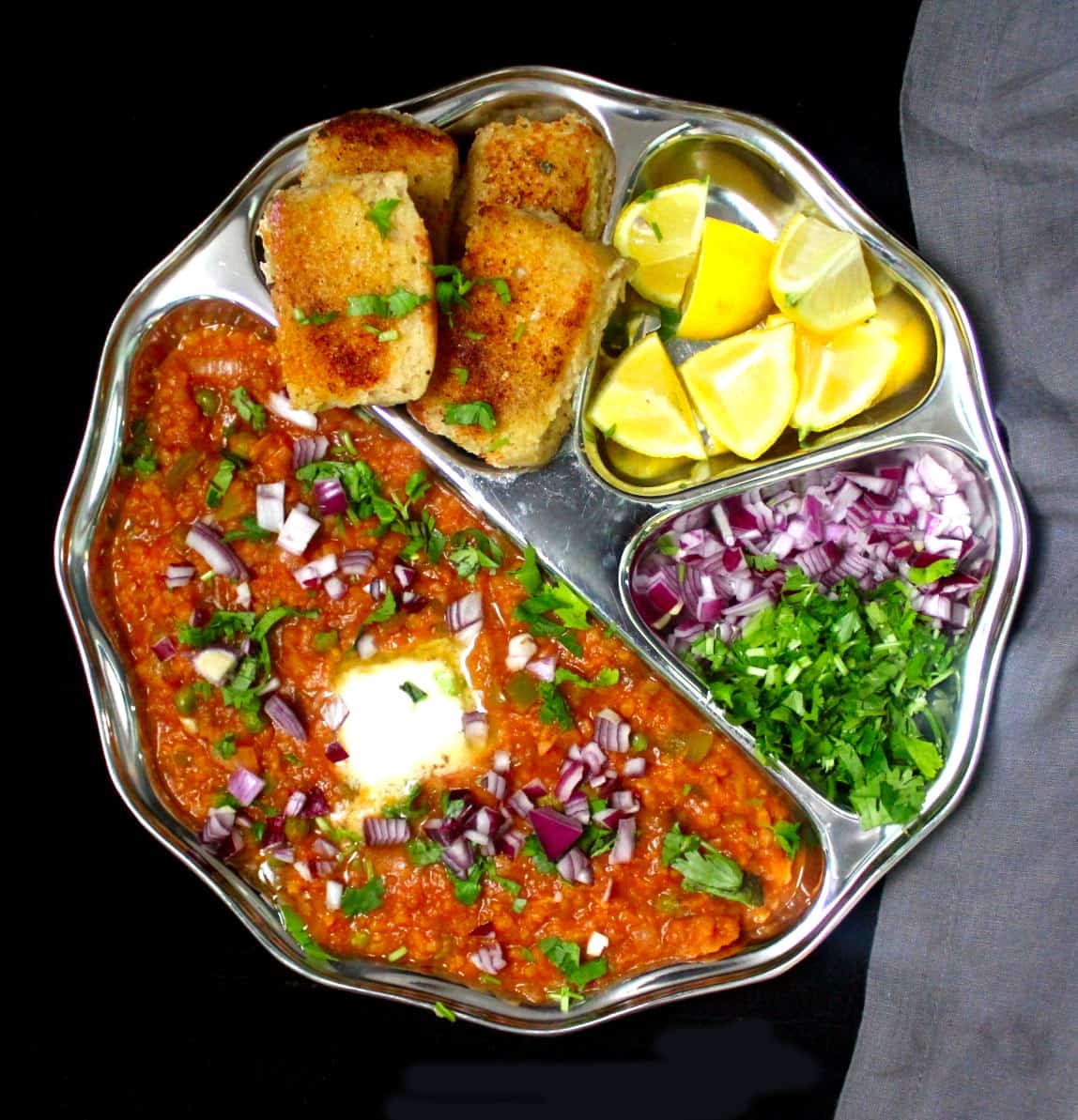
The story of Bombay or Mumbai, a city unlike any other, is inextricably woven with its vibrant street food: a smorgasbord of dishes so incredibly delicious that you cannot help but fall in love after a single taste. And one of the most unique of these dishes is Pav Bhaji, a fiery-red but not too spicy vegetable mash that's scooped up with a fluffy, buttery, toasted bread roll called a "pav."
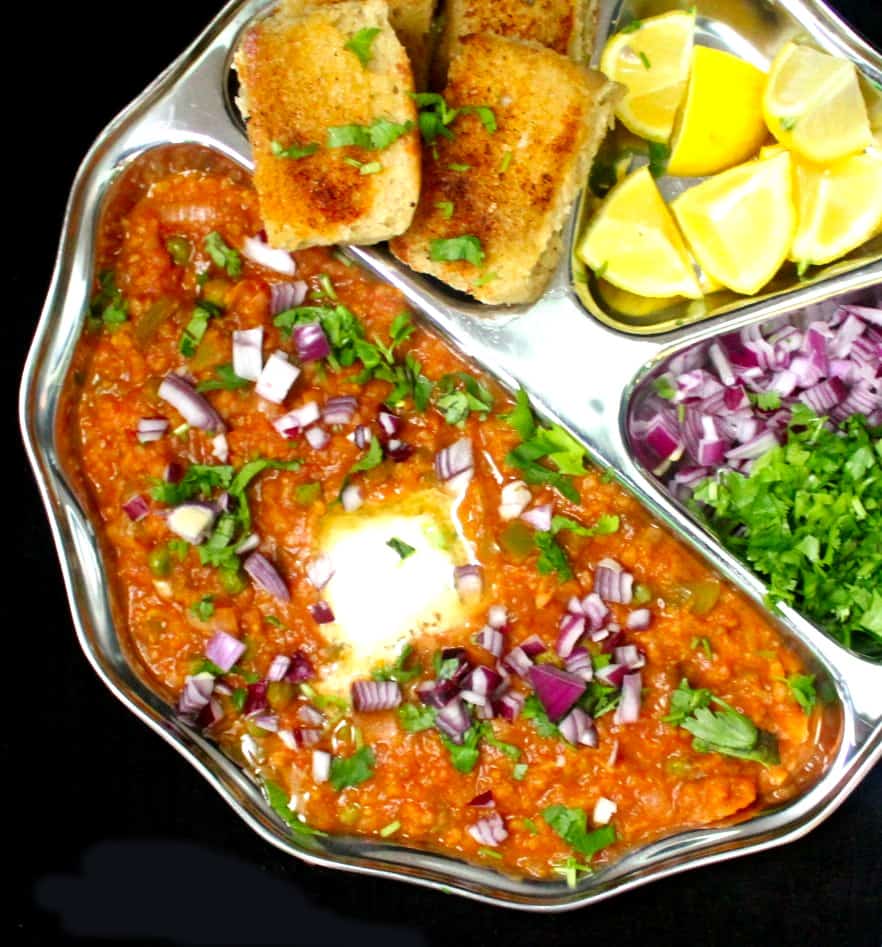
This is the food of the masses, food that sprung up in makeshift stalls outside the city's mills and factories and railway stations to fulfill workers' need for cheap, easily accessible and quickly served eats during the workday and especially at lunch.
Vendors borrowed elements of home cooking, took what was at hand, easily available, and not easily spoilt, and threw it all on their screeching-hot, three-foot-wide tavas (griddles) with a good dose of butter and spice. Then, using square steel spatulas that went clackety-clack on the tava, they mixed it all together into something incredibly delicious and even moderately healthy (although not remotely hygienic).
Restaurants were quick to cash in on the popularity of street food by introducing versions of it that you could eat in more sanitized surroundings. And while most "street food style" restaurants serve great approximations, the fact is that to truly savor Bombay's street food, you should be eating it standing up, with the pavement under your feet and the sound of the city thundering in your ears.
As a Bombay gal through and through (although I haven't lived in my city of birth for over two decades now), street food runs thick in my veins. I love it all, but if I have to pick one favorite, it would have to be Pav Bhaji.
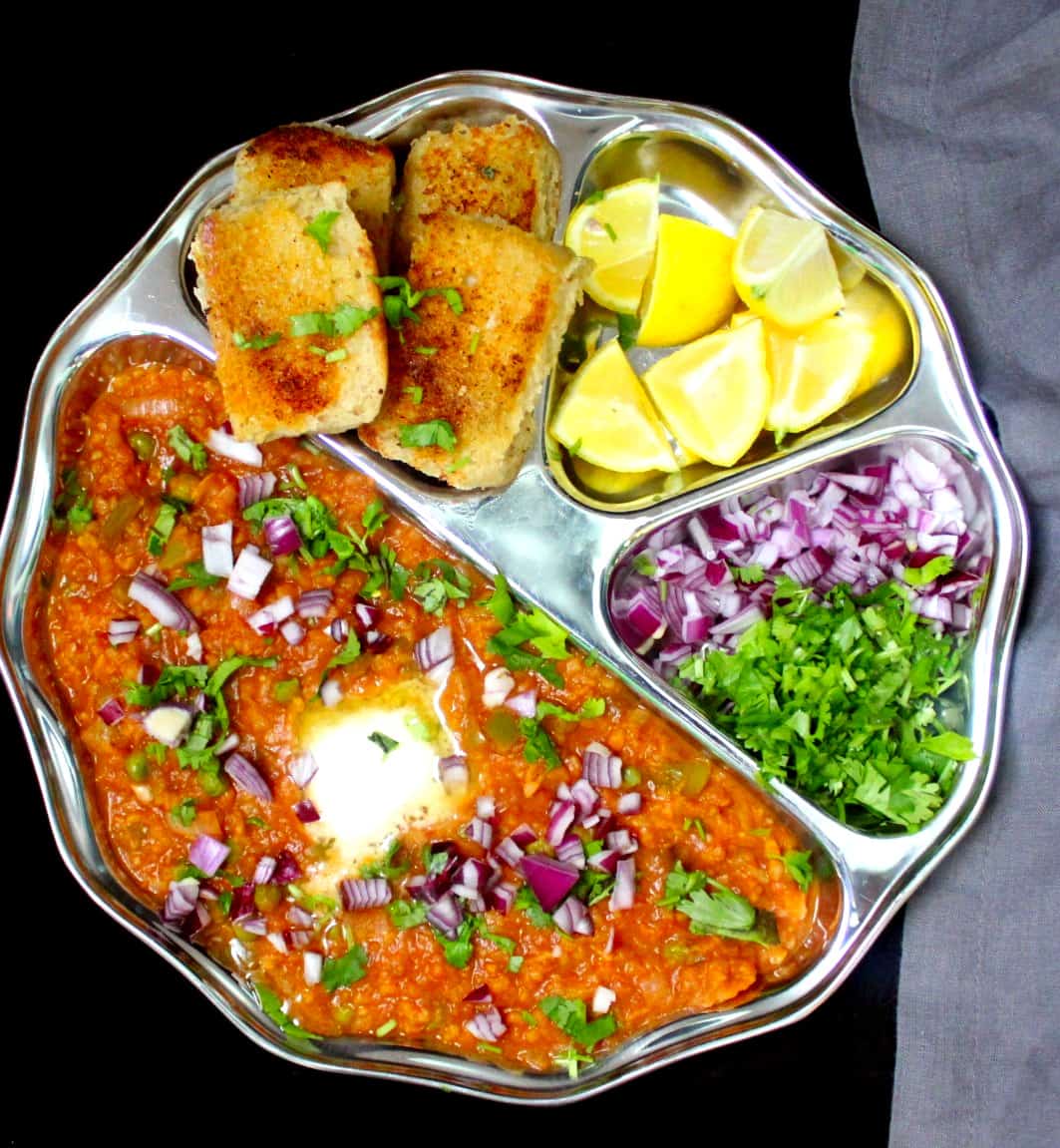
Expert tips for delicious Pav Bhaji
- A pav bhaji has two elements--the bhaji, or the vegetable mash, and the pav, the soft bread roll. I have recipes for both today, and the bread is delicious and quite easy to make. But if you balk at the idea of baking bread, or just don't want to go to the trouble, use any soft roll. I usually have hamburger rolls or hot dog rolls on hand for Jay and I don't hesitate to use them in lieu of the pav when needed. Street food is born of convenience--don't hesitate to use that fact to your benefit.
- The bhaji usually incorporates five easily found vegetables -- onions, tomatoes, peas, green bell peppers and cauliflower. Try and stick with these and avoid the temptation to sub, because you want your pav bhaji to have a certain texture.
- You can use fresh tomatoes here, or you can use canned tomatoes. If diced tomatoes are what you have, puree them up first before adding them to the wok.
- Don't skip the green bell peppers. And don't substitute them with bell peppers of other colors. For the longest time, before red, yellow and orange bell peppers arrived in Indian markets, the only kind of bell pepper Indian cooks used was the green. And most Indian dishes that use bell peppers still call for green bell peppers which have a unique, savory flavor that goes beautifully with Indian spices. They are especially good in the Pav Bhaji. Other colored bell peppers tend to be sweet and ruin the dish so don't use them and I really don't care about how much Vitamin A they provide. With street food, taste is king.
- You can use either fresh or frozen cauliflower in this dish, and if you have riced cauliflower feel free to gloat because you have just saved yourself some extra work.
- Any kind of potatoes work here, but because russet potatoes mash the easiest, I prefer using them in this dish. Be sure to peel them after boiling--you don't want potato skins in your Pav Bhaji. If you don't have russet potatoes, any other kind is fine too. Make sure you mash them up well after adding them to the bhaji.
- There is just one specialty ingredient you will need for your Pav Bhaji--a Pav Bhaji masala powder. This is easily found at Indian groceries and online. Indian cooks will often cite a favorite, but I just buy whichever I can find and they all work.
- One thing to keep in mind when you make your bhaji is that although it should be well-flavored, it should also not be overwhelmingly spicy or come on strong. Street food tastes as good as it does because it smothers the main dish under layers of flavors--usually onions, cilantro, lemon and, in case of Pav Bhaji, butter. That's its secret, and you'll do well not to deviate.
- Street vendors and restaurants usually mash the bhaji into a really pasty mush, but I like a little bit of texture in the veggies. So although I too go at it with the potato masher, I stop short of making a paste. That said, you do want all of your vegetables to break down quite fine, including the peas, for the true flavor of pav bhaji to shine through. Don't put it in a blender, please.
- You will need finely chopped onions, wedges of lemon, minced cilantro and some vegan butter on the side when you serve your Pav Bhaji. These are not optional--they are essential.
Ingredients
For the bhaji
- Vegetable oil
- Aromatics: Onions, ginger, garlic
- Spices: 2 green chili peppers (jalapeno, serrano, or any other, finely minced), cumin seeds, paprika or Kashmiri chilli powder, pav bhaji masala.
- Vegetables: tomatoes, green peas, potatoes, cauliflower, green bell pepper.
- Salt to taste
For the pav (bread roll)
- All purpose flour (can sub with half whole wheat flour for a healthier version)
- Active dry yeast
- Baking soda
- 1 tsp salt
- Milk of your choice. I used almond milk.
- Sugar
- Vegetable oil
For serving:
- Onion, cilantro, vegan butter and wedges of lemon.
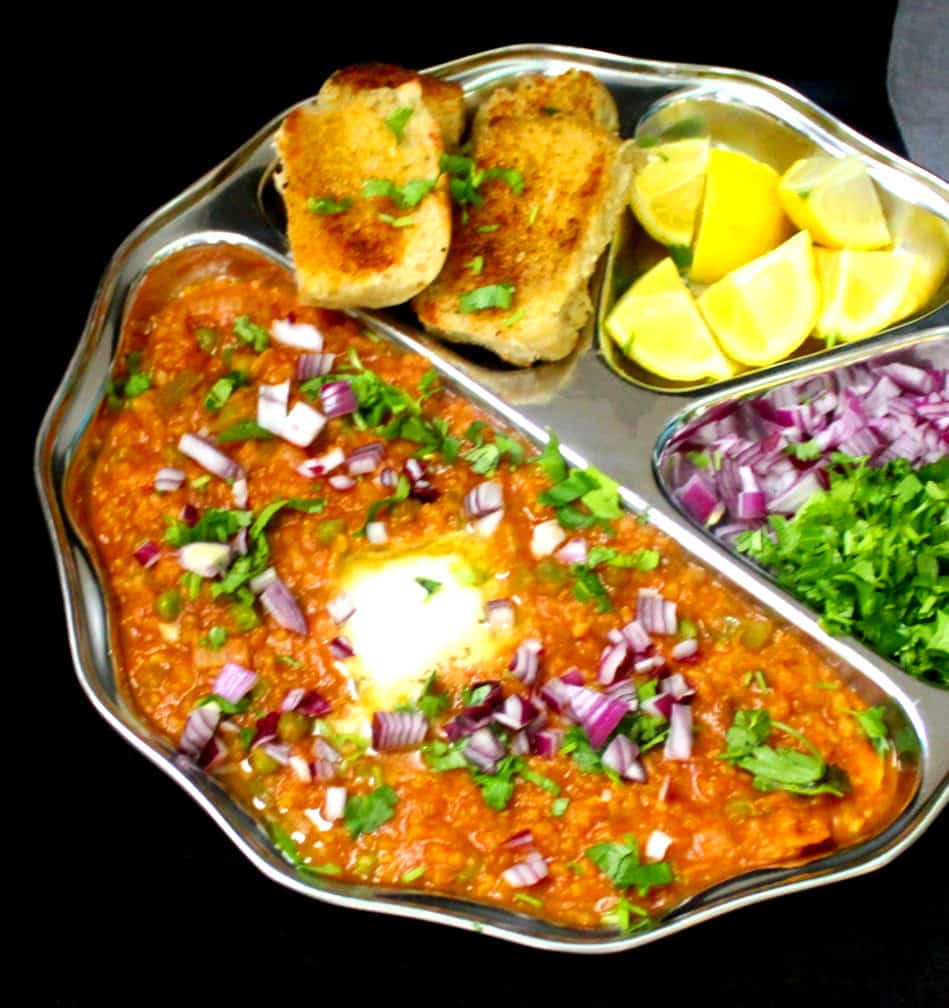
Method
Make the bhaji:
- Crush the ginger, garlic, cumin and green chile peppers into a paste using a mortar and pestle or a food processor.
- Heat the oil in a wide skillet or preferably a wok
- Add the onions and saute, until golden spots appear. Add the ginger-garlic paste and continue to saute another minute.
- Add the tomatoes and cook over high heat until they begin to darken. Add in the grated cauliflower, peas and bell peppers along with ½ cup water and salt. Cover and cook for five minutes or until the veggies are quite soft.
- Add in the boiled potatoes along with the pav bhaji masala, paprika if using, and about 1 ½ cups water or enough to make a thick, gravy-like consistency. You don't want the bhaji to be runny, but it should not be too dry either.
- Using a masher, mash down the veggies until most of them are broken down. After the bhaji comes to a boil, turn up the heat, and cook the veggies over high heat for five minutes, stirring constantly to ensure they don't stick. This helps roast some of the veggies and gives your pav bhaji an authentic flavor, much as something from the streets would taste. If the veggies get too dry at any point, add more water. Remember, you want a scoopable, sludgy consistency.
- You can add more pav bhaji masala if you like--go with your tastebuds, but remember it shouldn't be too strongly flavored. Add more salt if needed before turning off the heat.
Make the pav:
- Mix the sugar, ½ cup warm water and the yeast in a mixing bowl and set aside for about 5minutes until the mixture starts to froth, indicating the yeast is alive and well.
- Sift the flour and baking soda into the bowl. Knead on low speed in a stand mixer or by hand for about 3 minutes, trickling in enough milk until you have a dough that’s smooth but slightly sticky (I needed ¾ to 1 cup of milk).
- Add the oil and continue to knead until the oil has been absorbed by the dough, about 1 more minute.
- Now place in an oiled bowl, turning over once to coat all over with oil, cover with a kitchen towel, and set aside for 2 hours until the dough has risen.
- Punch down the dough and divide into 12 balls
- Shape them into a slightly rectangular shape by pulling at the sides of the dough and tucking under on all four sides.
- Place the tolls in a rectangular 9 X 13 inch baking dish smeared with oil and lightly floured, or on a cookie sheet, close enough but not touching each other. Let the rolls rise for 30 minutes. They will join at the ends when they have risen.
- Preheat the oven to 370 degrees. Brush the tops of the pavs with the a mixture of 1 teaspoon oil and 1 teaspoon non dairy milk mixture which gives them a nice color on top.
- Bake 22 minutes. Then turn off the oven and let the pav stand inside for another 4 minutes before removing it from the oven and allowing it to cool for 10 minutes on a rack.
How to serve the Pav Bhaji
There's a definite way to do this. 😉 Once you have the pav and bhaji cooked, slit the pav down the middle, but leave it connected at the spine if possible, like an open book. Then toast it, cut side down, on a screaming-hot skillet with some melting hot vegan butter and pav bhaji masala or paprika until golden spots appear.
The bhaji has to be served hot, topped with a pat of vegan butter that complements the spicy-tangy-salty veggies perfectly. Swirl the butter around the bhaji, mix in some chopped onions and chopped coriander, and squeeze in a few drops of lime.Now you're ready to eat.
Tear off a piece of the soft pav and dunk it into the bhaji and then into your mouth. No spoons and forks and knives here, folks. You can wash your hands before and after you eat. Even Desi, who can barely eat a chapati without a knife and fork, uses his fingers for Pav Bhaji. There just is no other way to enjoy it.
Finally, no Bombay street food is complete without a cup of chai, so pour yourself some vegan cutting chai to wash down the pav bhaji.
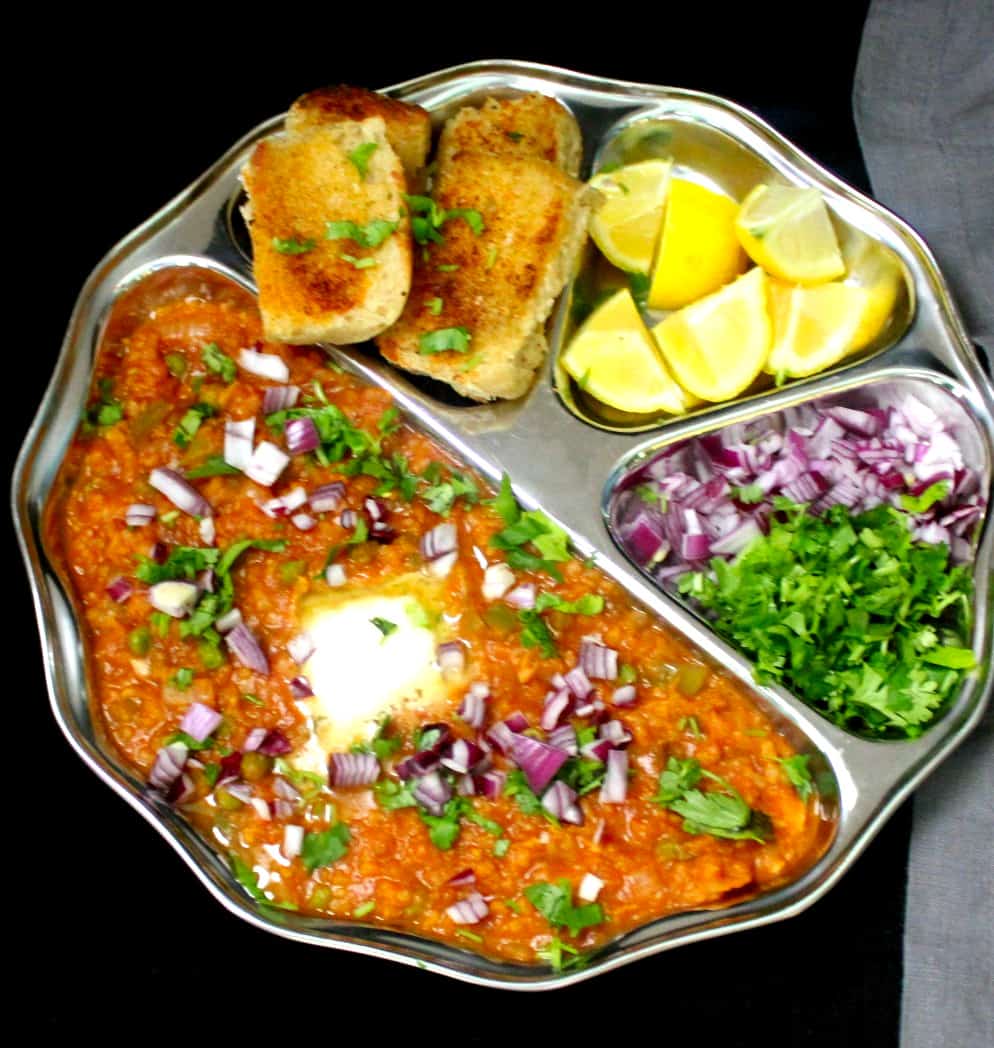
More Mumbai street food recipes
- Misal Pav
- Vegetable Frankie
- Bread Pakora
- Vada Pav
- Vegan Cutting Chai
- Here's another recipe you can make with Pav Bhaji masala: Tawa Pulao

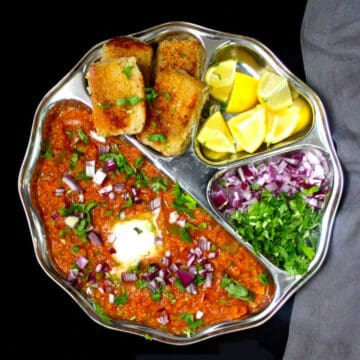
Pav Bhaji
Equipment
- Wok or wide skillet
- 19 X 13 baking dish
Ingredients
For the bhaji:
- 1 tablespoon avocado oil or any neutral oil
- 1 large onion (finely chopped)
- 1-inch knob ginger
- 6 cloves garlic
- 2 green chili peppers (jalapeno, serrano, or any other, finely minced)
- 1 teaspoon cumin seeds
- 3 tomatoes (chopped finely. If using canned diced tomatoes, puree them)
- 1 cup green peas (If using frozen use directly. If using fresh, cook first until soft)
- 2 large potatoes (boiled, peeled, and coarsely mashed)
- ½ head cauliflower (about 3 cups grated. You can use cauliflower rice as well)
- 1 green bell pepper (seeded and finely chopped)
- 2 heaping tbsp Pav Bhaji masala
- 1 teaspoon paprika (or Kashmiri chili powder, optional, mainly for color)
- Salt to taste
For the pav:
- 3 cups unbleached all purpose flour (can sub with half whole wheat flour for a healthier version)
- 1 ½ teaspoon active dry yeast
- ½ teaspoon baking soda
- 1 teaspoon salt
- ¾ to 1 cup nondairy milk
- 2 teaspoon sugar
- 3 tablespoon avocado oil or any neutral oil
For serving:
- 1 red onion (finely chopped)
- ¼ cup cilantro (finely chopped)
- vegan butter
- Wedges of lemon
Instructions
Make the bhaji:
- Crush the ginger, garlic, cumin and green chile peppers into a paste using a mortar and pestle or a food processor.
- Heat the oil in a wide skillet or preferably a wok
- Add the onions and saute, until golden spots appear. Add the ginger-garlic paste and continue to saute another minute.
- Add the tomatoes and cook over high heat until they begin to darken. Add in the grated cauliflower, peas and bell peppers along with ½ cup water and salt. Cover and cook for five minutes or until the veggies are quite soft.
- Add in the boiled potatoes along with the pav bhaji masala, paprika if using, and about 1 ½ cups water or enough to make a thick, gravy-like consistency. You don't want the bhaji to be runny, but it should not be too dry either.
- Using a masher, mash down the veggies until most of them are broken down. After the bhaji comes to a boil, turn up the heat, and cook the veggies over high heat for five minutes, stirring constantly to ensure they don't stick. This helps roast some of the veggies and gives your pav bhaji an authentic flavor, much as something from the streets would taste. If the veggies get too dry at any point, add more water. Remember, you want a scoopable, sludgy consistency.
- You can add more pav bhaji masala if you like--go with your tastebuds, but remember it shouldn't be too strongly flavored. Add more salt if needed before turning off the heat.
Make the pav:
- Mix the sugar, ½ cup warm water and the yeast in a mixing bowl and set aside for about 5minutes until the mixture starts to froth, indicating the yeast is alive and well.
- Sift the flour and baking soda into the bowl. Knead on low speed in a stand mixer or by hand for about 3 minutes, trickling in enough milk until you have a dough that’s smooth but slightly sticky (I needed ¾ to 1 cup of milk).
- Add the oil and continue to knead until the oil has been absorbed by the dough, about 1 more minute.
- Now place in an oiled bowl, turning over once to coat all over with oil, cover with a kitchen towel, and set aside for 2 hours until the dough has risen.
- Punch down the dough and divide into 12 balls
- Shape them into a slightly rectangular shape by pulling at the sides of the dough and tucking under on all four sides.
- Place the tolls in a rectangular 9 X 13 inch baking dish smeared with oil and lightly floured, or on a cookie sheet, close enough but not touching each other. Let the rolls rise for 30 minutes. They will join at the ends when they have risen.
- Preheat the oven to 370 degrees. Brush the tops of the pavs with the a mixture of 1 teaspoon oil and 1 teaspoon nondairy milk mixture which gives them a nice color on top.
- Bake 22 minutes. Then turn off the oven and let the pav stand inside for another 4 miuntes before removing it from the oven and allowing it to cool for 10 minutes on a rack.
Serve the Pav Bhaji:
- The pav needs to be toasted before serving. To do this, heat a griddle. Slit the pav into two, then smear on some butter and, if you like, sprinkle on some paprika or pav bhaji masala directly on the pav. Place, crumb-side down, on the hot skillet and let the pav toast a minute or so until golden-brown.
- Next ladle out the piping-hot bhaji on a plate or in a bowl. Add a square of vegan butter and then sprinkle the top with onions and cilantro and squeeze on some lemon juice. Serve with the toasted pav.

Santhoshi Shanmuga
Hi can sour dough discard be used to make the pav???
You are such amazing recipes thankyou so much...
Vaishali
Hi Santhoshi, absolutely, you can add a cup of recently fed sourdough discard. Make sure you do one overnight rise.
DH
10 million years ago ('89-90) I was a high school exchange student in Jalgaon Maharashtra. My host mother actually made pav bhaji, sometimes with store bought pav, sometimes with homemade poori. Somewhere, I have a carefully written recipe in Marathi (I learned how to read & write it) with english translation.
Right before this current pandemic situation, I vowed to start making it at homebut never got a chance to pop over to Jackson Heights to get the masala!!
This may very well be the first thing I make as soon as I get a chance...
Vaishali
Hi DH, I'm amazed that you learned to read and write Marathi! Thanks for sharing your beautiful memory, it brought a smile to my face. I hope you will make this someday and hope it brings back more good memories. 🙂
Suzanne
Hi VAISHALI,
I recently signed up to your website as your recipes look fantastic. Today's Pav Bhaji sounds great. I saw you say the green peppers are a must to be authentic. I see also that many of your recipes have bell peppers in them. Unfortunately I can't eat bell peppers can you recommend a suitable substitute?
Sincerely,
Suzanne
Vaishali
Hi Suzanne, if you can't eat bell peppers leave them out. You can just add more green peas.
Anonymous
Enjoyed eating the fresh Pav and bhaji at your place. It was outstanding. Now that I have the recipe I will try to make. Niru
Vaishali
Niru, it was so good to see you and Badri again after so long. Glad you enjoyed the pav-bhaji!
nivi
Hi Vaishali,
I was browsing to check for vegan cupcake recipes and stumbled upon your website. First it was the cupcake recipe, then it was the adventures of Opie and now the nostalgia of Mumbai. I worked in Nariman Point too, and all the yummy food, chilling out at Marine Drive and the funny things you have written about Mumbai, makes me want to reach to you. Thanks so much for your recipes and also your funny style of making things come alive. Love to Opie and the other members of family.
Cheers,
Nivedita
Vaishali
Nivedita, welcome to the blog and thanks for your kind words! Good to meet another Bombayite. Opie sends a big tail-wag. 🙂
Usha
I am with you on not having had a pav bhaji on the streets of Mumbai that I disliked...having said that this one looks like a real winner 🙂
Ashwini
never tried making pavs at home.. u did it like a pro...